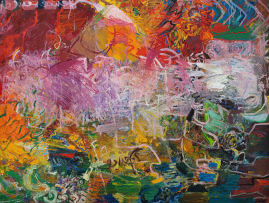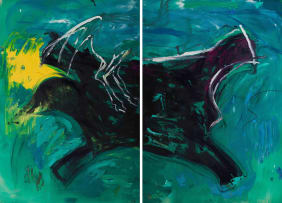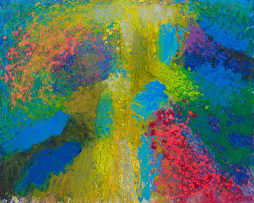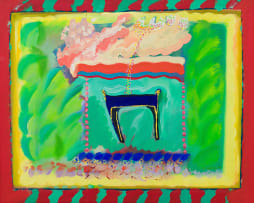Mphogoli III
Rudzani Nemasetoni
About the SessionThe Engen Collection is a corporate collection that highlights a crucial chapter in South African art history.
Initially put together as the Mobil collection in the early 1980s, it brings to market a selection of works from a broader archive of over two hundred artworks, offering insights into the networks, pedagogies and creative resistances that shaped South African abstract art in the early 1980s. It comprises of paintings, tapestries, works on paper and photographs representing a significant corporate investment in South African contemporary art during a period of intense cultural and political transformation. The collection engages with a moment when South African artists were developing visual languages that could operate across the cultural and artistic boundaries. These artists, including Bill Ainslie, Simon Stone, Gabriel Tsolo, Judith Mason, Andrew Verster, Pippa Skotnes and Gail Altschuler, documented individual artistic development alongside the collective creation of alternative artistic practice.
The collection traces the intellectual and artistic genealogy of artists working within and against the constraints of the 80s, many of whom were influenced by the South African artist, teacher and activist Bill Ainslie and the Johannesburg Art Foundation (JAF), an institution that maintained inclusivity. Founded in 1982, JAF operated as an educational anomaly, rejecting prescribed curricula and external authority in favour of emancipatory and experimental pedagogy. Under Ainslie's direction, the Foundation fostered abstract expressionism, an art movement whose rejection of traditional representational art prioritised non-objective imagery to evoke emotion. The connections of the institution extended beyond the JAF itself, linking to the establishment of Federated Union of Black Artists (FUBA) and the Thupelo Workshops in Cape Town, institutions whose impact continues to shape contemporary South African art discourse.
The CEO, Mr George Roberts, said: "The Engen Collection represents a broad and vibrant range of South African artists and has been a treasured part of our company’s story for many years. As we look to the future, we believe it is time for these remarkable artworks to find new homes where they can continue to be appreciated, shared and celebrated. We believe that by releasing this collection, the artworks will find new life amongst a wider community, while inspiring new audiences by continuing to tell the story of South Africa’s creative spirit."
Incl. Buyer's Premium & VAT
About this Item
signed, dated 85 and inscribed with the title on the reverse
Literature
R J Angel (no date) Mobil Court Art Collection: A Collection of South African Visual Art, Mobil Oil Southern Africa, illustrated in colour, unpaginated, with the title Mphogoli 2.
Notes
Mphogoli is a figure from Venda folklore - a tall, slender, shape-shifting creature, cloaked in a bright costume adorned with an assortment of clanking objects. Known to roam villages in search of children, it would lure them with its strange charm, only to kidnap them. For many, Mphogoli was just a story. For the Nemasetoni, it was a recurring nightmare.
Throughout the early to mid-1980s, the artist began creating a haunting series of paintings inspired by this legend. Tormented by dreams in which Mphogoli pursued him relentlessly, the artist recalled being unable to reach the safety of home. The sound of the creatures clanking costume echoed long after waking, a symbol of terror that refused to fade.
But these nightmares did not arise in isolation. South Africa's most violent and tumultuous decade - the 1980s - formed the backdrop. As the apartheid state cracked down with increasing brutality, violence became an everyday presence: death squads, mobs, lynchings and disappearances. The young artist bore witness to it all - overwhelmed by confusion and unable to imagine a different reality.
Art became Nemasetoni's refuge and survival tool. Painting Mphogoli was more than storytelling - it was therapy. Each brushstroke was an act of defiance against the psychological toll of apartheid, a means of externalising inner chaos and reclaiming personal agency. Nemasetoni describes:
"In essence, therefore, Mphogoli became a metaphor and outlet I used to express and confront my fears and anxieties. In doing so, I was able to preserve my sanity. I was also able to gain rationality and personal freedom while living in a society that stifled it with fear."¹
Through Mphogoli, the artist transformed trauma into expression, myth into metaphor -laying bare the psychological landscape of a generation scarred by oppression, yet yearning for freedom.
Rudzani Nemasetoni was born in 1962 in Johannesburg, South Africa. He began his formal art training in 1983 at the Johannesburg Art Foundation - an influential institution founded by Bill Ainslie - where he focused on drawing and painting. Following this, he was awarded a scholarship by the African Arts Fund, a New York-based philanthropic organisation, to pursue further studies at Hunter College in New York City. There, he earned a Bachelor of Fine Arts in Painting in 1990, followed by a Master of Fine Arts in Painting in 1995. Nemasetoni has received notable accolades, including funding from The Pollock-Krasner Foundation. His work has been exhibited in Johannesburg and at the 1985 Triangle Artists' Workshop in New York, an international residency program founded by the esteemed British sculptor Anthony Caro (1924-2013).
1. Correspondence with the artist, 2025.
Thanks to Rudzani Nemasetoni for assistance in the cataloguing of this lot.
Provenance
The Engen Collection.









